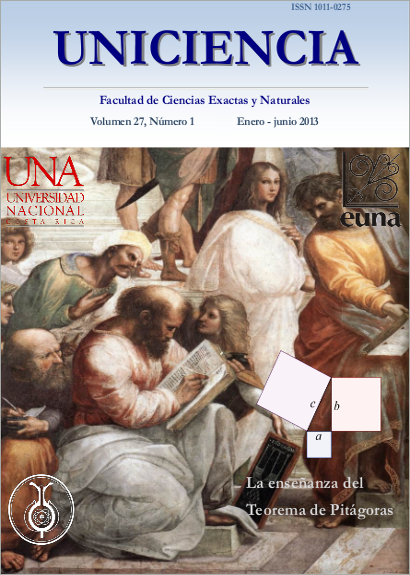Evaluation of the chemical composition (Phyllanthosides and Lignans) of the crude extract of the Chilillo tree (Phyllanthus Acuminatus Vahl) from different sites of Costa Rica
Keywords:
Phyllantus, phyllanthosides, chillillo tree, polyphenols, antioxidantsAbstract
The purpose of this research work was in the first instance, to conduct a study of the content of phyllantosides and lignans in samples from different parts of the tree known as “Chilillo” (Phyllanthus acuminatus Vahl), collected at different sites of the country. The first objective of the study was focused on the characterization of the samples using high efficiency liquid chromatography (HPLC). The results obtained by this technique showed variation not only in the number of peaks in each chromatogram, but also in the peak intensity, also significant variations in the composition of the samples were found among the different collecting sites. The second objective of this work, was to develop a simple, fast and inexpensive colorimetric method to quantify the content of phyllantosides and lignans in different samples of Chilillo that was comparable to the HPLC data. The results obtained with the new method were correlated with the results obtained by HPLC, the coefficient of determination obtained in this correlation was excellent and statistically significant (R2 = 0,99; p < 0,05). Finally, the last objective of the study was to evaluate the antioxidant activity in all the samples of Chilillo and its correlation with its total polyphenolic content, using the free radical 2,2-diphenyl-1-picrylhydrazyl (DPPH) for antioxidant activity determinations and Folin-Ciocalteu for total polyphenolic content. Traditionally there is a good correlation between total polyphenol content and antioxidant activity, but in this study the correlation between the two methods was relatively low (R2 = 0.4334). These results clearly show that Chilillo tree can not be consider as an important source of polyphenols or natural antioxidants, especially when compared with other plant samples rich in phenolic compounds such as blackberry (Rubus sp) or rambutan (Nephelium lappaceum).Downloads
Published
Issue
Section
License
Authors who publish with this journal agree to the following terms:
1. Authors guarantee the journal the right to be the first publication of the work as licensed under a Creative Commons Attribution License that allows others to share the work with an acknowledgment of the work's authorship and initial publication in this journal.
2. Authors can set separate additional agreements for non-exclusive distribution of the version of the work published in the journal (eg, place it in an institutional repository or publish it in a book), with an acknowledgment of its initial publication in this journal.
3. The authors have declared to hold all permissions to use the resources they provided in the paper (images, tables, among others) and assume full responsibility for damages to third parties.
4. The opinions expressed in the paper are the exclusive responsibility of the authors and do not necessarily represent the opinion of the editors or the Universidad Nacional.
Uniciencia Journal and all its productions are under Creative Commons Atribución-NoComercial-SinDerivadas 4.0 Unported.
There is neither fee for access nor Article Processing Charge (APC)






